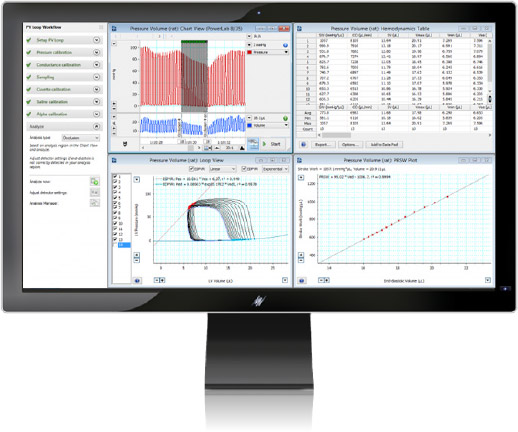Best Practices for Surgical Procedures with Millar Catheters
Expert tips for calibrating, handling, cleaning and storing your Millar catheter.
Surgery performed at the René Remie Surgical Skills Centre by Prof. René Remie. Animal handling and surgical procedures all strictly follow Dutch Legislation on Laboratory Animals and was approved by the IACUC.
Best practices:
Surgical Instruments
It cannot be emphasized enough how important good surgical instruments are to performing good surgery, and in turn, recording good data.
The instruments used in the surgical instructional videos on our website are featured below:
- Artery Forceps
- Big Scissors, sharp/sharp, straight
- Needle Holder
- Small Scissors, sharp/sharp, straight
- Tissue forceps for rats
- Tissue forceps for mice
- Anatomical forceps curved 90 degrees
- Anatomical forceps straight
- Two jewelers forceps curved 45 degrees
- Straight Jewelers forceps, used to stretch the jugular vein
- Tubing inducing forceps, for handling the catheter
- Clamp applying forceps
- Micro scissors
- Finally, beamer clamps or clips
Catheter soaking
It is important to soak the catheter in 37 degrees isotonic saline for at least 30 minutes before zeroing, calibration, and inserting the catheter into the animal. This is done to prevent baseline drift.
- Make sure the catheter is connected to the Bridge Amp or MPVS ultra and that the equipment is on while soaking the catheter.
Covering forceps tips with silicone tubing
If forceps or other surgical tools are used to grip and introduce the catheter, it is best to cover the tips of the instruments with some silicone tubing.
- First, cut small pieces of tubing as shown in the video at 02.07.
- These can then be put over the ends of the instrument using your fingers as demonstrated here.
- This will cushion the interface with the catheter.
Catheter guide for right ventricular catheterization
Next, we are going to make a simple catheter guide from some PE-60 tubing. The purpose of the guide is to facilitate insertion of the catheter into the right atrium via the jugular.
- The inner diameter of the PE-60 tubing is 0.76mm or 0.3 inches, which is large enough for a 2F catheter to pass through.
- Using a permanent marker, make a mark at 40mm from the end of the tubing. This will give an indication of where the tip is situated inside the animal.
- On average the apex of the right ventricle is around 35-40mm from the midline of the neck.
- Bend the tubing at about 10mm from the end at a 45 degree angle and quickly dip this in hot water. The tubing should now hold its shape when removed from the hot water.
- You can now attach this guide to a syringe needle for easy handling.
Making a simple catheter introducer
Make a simple catheter introducer from a 23 gauge syringe needle for rats and a 25G or even 27G needle for mice.
- With the bevel of the needle facing up, using a needle holder, bend the tip to almost 90 degrees.
- Subsequently, you can bend the needle a little bit to one side so as to prevent your fingers from being in the field of view when performing the catheterization.
- Create a simple catheter introducer by attaching the needle onto a syringe.
Cleaning and storing the catheter
It is important to clean the catheter after every use.
- Once removed from the animal, place the catheter in a syringe filled with distilled water and Tergazyme solution for 10 to 15 minutes.
- Then, using a cotton swab dipped in Tergazyme solution, clean off any remaining tissue residue, using the technique illustrated here.
- Check that the catheter sensor is clean under a microscope.
- Next wash off the Tergazyme with clean distilled water and let it dry.
- Finally place the catheter tip in the anti electro-static discharge sponge, as shown, before placing the catheter back in its tray. Store the catheter in a dark, cool, and dry place.
We hope you found these tips useful.
Please visit our comprehensive Millar Best Practice Tips page for more specialized information and useful resources relating to caring for your Millar pressure and pressure-volume catheters.
If you have any questions, please contact your ADInstruments support representative who will be happy to provide specific information and assistance with your research requirements.
Return to Surgical Instruction Video Series Main Page »
Additional resources
- Cardiac PV Loop Data Analysis: Tips & Tricks (Webinar) »
- PV Tips and Tricks: Expert advice for measuring pressure-volume loops in mice »
- Optimizing your Blood Pressure and Pressure-Volume Recordings »
- Cardiovascular Assessment of Pressure-Volume and Blood Pressure »
- Introduction to PV loops: Understanding the PV loop and measures of cardiac function »
- Troubleshooting your Millar Catheter: Three common problems and how to fix them »
LabChart software - PV Loop 2.5 for left and right ventricle studies
The PV Loop Analysis Software Module for LabChart is specifically designed for the analysis of in vivo ventricular pressure-volume data in small and large animals, or ex vivo, using working heart systems. Our PV loop module provides workflows for acquiring PV loop data from small and large animal models as well as tools for analyzing left and right ventricular PV data in real-time or post-acquisition. Contact us for more information.
